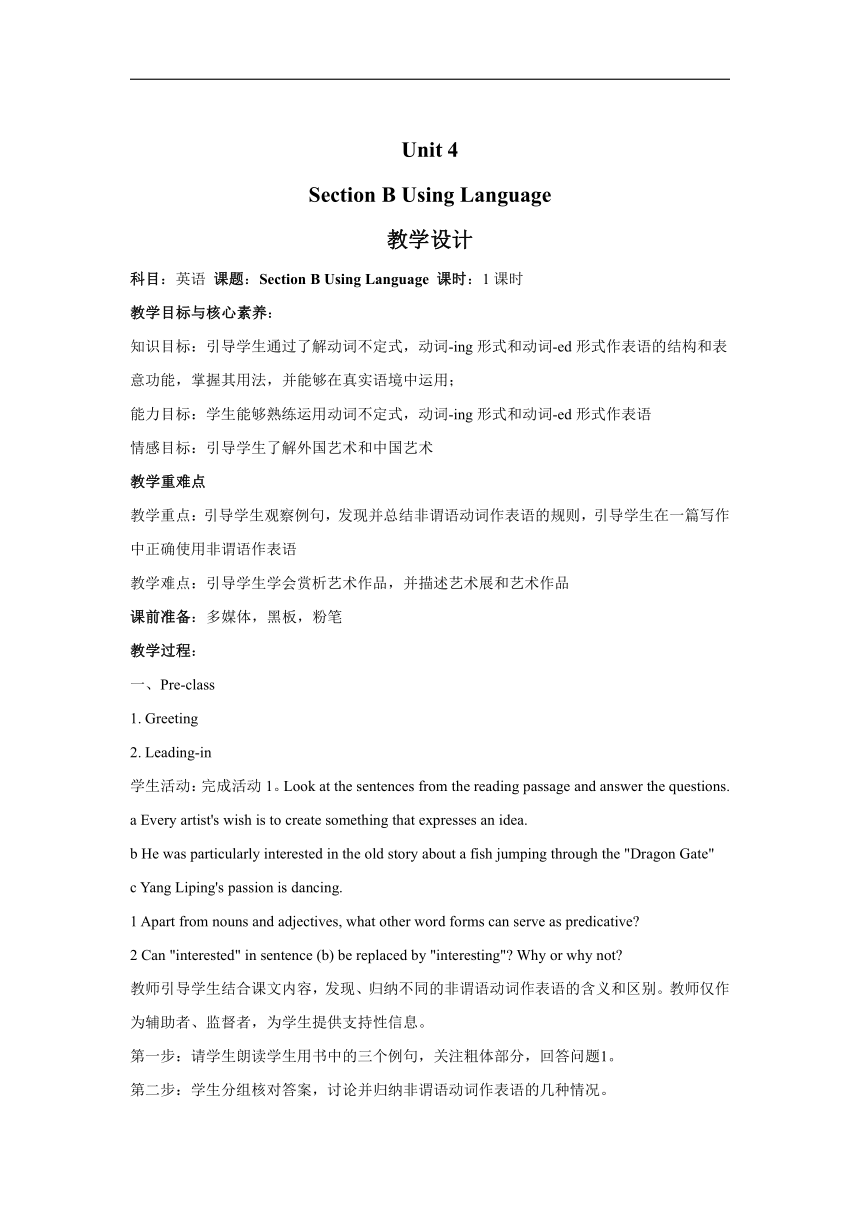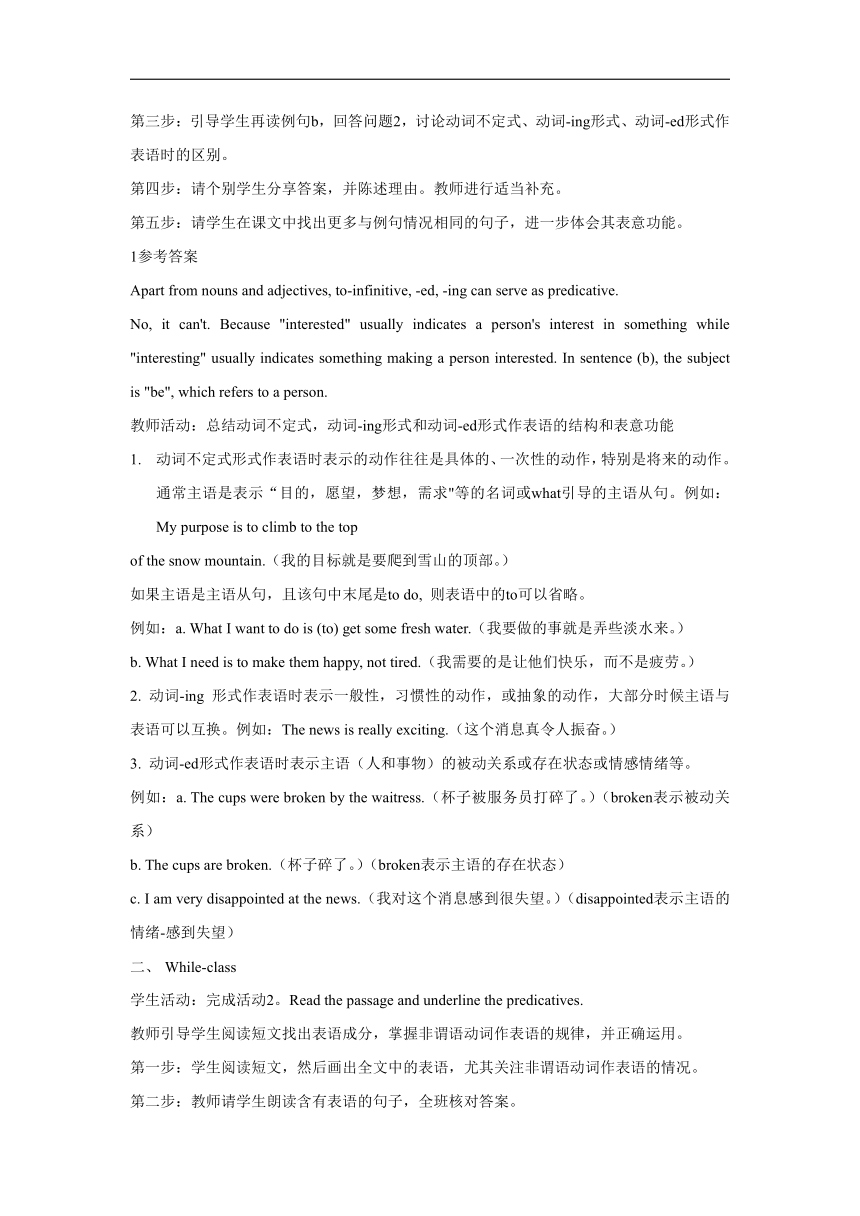外研版(2019)选择性必修第一册 Unit 4 Meeting the museSection B Using Language(教案)
文档属性
| 名称 | 外研版(2019)选择性必修第一册 Unit 4 Meeting the museSection B Using Language(教案) |

|
|
| 格式 | zip | ||
| 文件大小 | 127.5KB | ||
| 资源类型 | 教案 | ||
| 版本资源 | 外研版(2019) | ||
| 科目 | 英语 | ||
| 更新时间 | 2022-08-28 13:17:12 | ||
图片预览


文档简介
Unit 4
Section B Using Language
教学设计
科目:英语 课题:Section B Using Language 课时:1课时
教学目标与核心素养:
知识目标:引导学生通过了解动词不定式,动词-ing形式和动词-ed形式作表语的结构和表意功能,掌握其用法,并能够在真实语境中运用;
能力目标:学生能够熟练运用动词不定式,动词-ing形式和动词-ed形式作表语
情感目标:引导学生了解外国艺术和中国艺术
教学重难点
教学重点:引导学生观察例句,发现并总结非谓语动词作表语的规则,引导学生在一篇写作中正确使用非谓语作表语
教学难点:引导学生学会赏析艺术作品,并描述艺术展和艺术作品
课前准备:多媒体,黑板,粉笔
教学过程:
一、Pre-class
1. Greeting
2. Leading-in
学生活动:完成活动1。Look at the sentences from the reading passage and answer the questions.
a Every artist's wish is to create something that expresses an idea.
b He was particularly interested in the old story about a fish jumping through the "Dragon Gate"
c Yang Liping's passion is dancing.
1 Apart from nouns and adjectives, what other word forms can serve as predicative
2 Can "interested" in sentence (b) be replaced by "interesting" Why or why not
教师引导学生结合课文内容,发现、归纳不同的非谓语动词作表语的含义和区别。教师仅作为辅助者、监督者,为学生提供支持性信息。
第一步:请学生朗读学生用书中的三个例句,关注粗体部分,回答问题1。
第二步:学生分组核对答案,讨论并归纳非谓语动词作表语的几种情况。
第三步:引导学生再读例句b,回答问题2,讨论动词不定式、动词-ing形式、动词-ed形式作表语时的区别。
第四步:请个别学生分享答案,并陈述理由。教师进行适当补充。
第五步:请学生在课文中找出更多与例句情况相同的句子,进一步体会其表意功能。
1参考答案
Apart from nouns and adjectives, to-infinitive, -ed, -ing can serve as predicative.
No, it can't. Because "interested" usually indicates a person's interest in something while "interesting" usually indicates something making a person interested. In sentence (b), the subject is "be", which refers to a person.
教师活动:总结动词不定式,动词-ing形式和动词-ed形式作表语的结构和表意功能
动词不定式形式作表语时表示的动作往往是具体的、一次性的动作,特别是将来的动作。通常主语是表示“目的,愿望,梦想,需求"等的名词或what引导的主语从句。例如:My purpose is to climb to the top
of the snow mountain.(我的目标就是要爬到雪山的顶部。)
如果主语是主语从句,且该句中末尾是to do, 则表语中的to可以省略。
例如:a. What I want to do is (to) get some fresh water.(我要做的事就是弄些淡水来。)
b. What I need is to make them happy, not tired.(我需要的是让他们快乐,而不是疲劳。)
2. 动词-ing 形式作表语时表示一般性,习惯性的动作,或抽象的动作,大部分时候主语与表语可以互换。例如:The news is really exciting.(这个消息真令人振奋。)
3. 动词-ed形式作表语时表示主语(人和事物)的被动关系或存在状态或情感情绪等。
例如:a. The cups were broken by the waitress.(杯子被服务员打碎了。)(broken表示被动关系)
b. The cups are broken.(杯子碎了。)(broken表示主语的存在状态)
c. I am very disappointed at the news.(我对这个消息感到很失望。)(disappointed表示主语的情绪-感到失望)
While-class
学生活动:完成活动2。Read the passage and underline the predicatives.
教师引导学生阅读短文找出表语成分,掌握非谓语动词作表语的规律,并正确运用。
第一步:学生阅读短文,然后画出全文中的表语,尤其关注非谓语动词作表语的情况。
第二步:教师请学生朗读含有表语的句子,全班核对答案。
参考答案:
to see; tired; determined; called; sure; there; amazing; wide; parted
学生活动:完成活动3。Complete the passage with the correct form of the verbs in brackets.
Chinese artist Wu Guanzhong is 1______ (know) for his paintings using oils and also for those using the more traditional Chinese method of ink. According to Wu Guanzhong, his goal as an artist was
2 ______ (combine) Western principles of art with Chinese spirit, and his passion is 3 ______ (seek) a point at which the two could meet. To him, the important value of an artwork was 4 _____ (reflect) the art within the life of Chinese people and 5 _____ (express) love of and responsibility to his motherland. Wu Guanzhong remained 6 ______ (interest) in exploring ways of expression, with his style changing and developing throughout his career. His life's work is now 7 ______ (inspire) artists not only in China but across the world.
教师通过此活动请学生在具体语境中正确使用动词的适当形式,特别注意非谓语动词作表语的情况;同时引导学生进一步了解如何介绍一位艺术家及这位艺术家的作品和艺术灵感。
第一步:学生独立阅读活动语篇,理解语篇大意。
第二步:学生用括号里动词的适当形式完成填空。
第三步:请个别学生朗读完整的语篇,全班核对答案。
参考答案:
1 known
2 to combine
3 to seek
4 to reflect
5 to express
6 interested
7 inspiring
三、After-class
学生活动:学生分组完成活动4。Think of an artist you admire and talk about his or her inspiration and artworks using to-infinitive, -ing and-ed as predicative where appropriate.
本活动是迁移创新类活动,教师引导学生运用非谓语动词作表语介绍一位艺术家及这位艺术家的艺术灵感和作品,在真实的语境中运用已学语法知识,加深对已学语法知识的理解。
第一步:学生再次阅读活动3的语篇,重点关注语篇的结构和具体内容,以及所填写的动词形式。
第二步:学生分组,仿照活动3的语篇,介绍一位自己钦佩的艺术家及这位艺术家的艺术灵感和作品。小组成员轮流介绍。
第三步:各小组进行组内互评。
第四步:请各组推选一段口头介绍并在全班分享,教师进行点评。
Summary
老师根据课堂内容,总结课上的语法。
作业布置
完成本节课的同步练习。
Section B Using Language
教学设计
科目:英语 课题:Section B Using Language 课时:1课时
教学目标与核心素养:
知识目标:引导学生通过了解动词不定式,动词-ing形式和动词-ed形式作表语的结构和表意功能,掌握其用法,并能够在真实语境中运用;
能力目标:学生能够熟练运用动词不定式,动词-ing形式和动词-ed形式作表语
情感目标:引导学生了解外国艺术和中国艺术
教学重难点
教学重点:引导学生观察例句,发现并总结非谓语动词作表语的规则,引导学生在一篇写作中正确使用非谓语作表语
教学难点:引导学生学会赏析艺术作品,并描述艺术展和艺术作品
课前准备:多媒体,黑板,粉笔
教学过程:
一、Pre-class
1. Greeting
2. Leading-in
学生活动:完成活动1。Look at the sentences from the reading passage and answer the questions.
a Every artist's wish is to create something that expresses an idea.
b He was particularly interested in the old story about a fish jumping through the "Dragon Gate"
c Yang Liping's passion is dancing.
1 Apart from nouns and adjectives, what other word forms can serve as predicative
2 Can "interested" in sentence (b) be replaced by "interesting" Why or why not
教师引导学生结合课文内容,发现、归纳不同的非谓语动词作表语的含义和区别。教师仅作为辅助者、监督者,为学生提供支持性信息。
第一步:请学生朗读学生用书中的三个例句,关注粗体部分,回答问题1。
第二步:学生分组核对答案,讨论并归纳非谓语动词作表语的几种情况。
第三步:引导学生再读例句b,回答问题2,讨论动词不定式、动词-ing形式、动词-ed形式作表语时的区别。
第四步:请个别学生分享答案,并陈述理由。教师进行适当补充。
第五步:请学生在课文中找出更多与例句情况相同的句子,进一步体会其表意功能。
1参考答案
Apart from nouns and adjectives, to-infinitive, -ed, -ing can serve as predicative.
No, it can't. Because "interested" usually indicates a person's interest in something while "interesting" usually indicates something making a person interested. In sentence (b), the subject is "be", which refers to a person.
教师活动:总结动词不定式,动词-ing形式和动词-ed形式作表语的结构和表意功能
动词不定式形式作表语时表示的动作往往是具体的、一次性的动作,特别是将来的动作。通常主语是表示“目的,愿望,梦想,需求"等的名词或what引导的主语从句。例如:My purpose is to climb to the top
of the snow mountain.(我的目标就是要爬到雪山的顶部。)
如果主语是主语从句,且该句中末尾是to do, 则表语中的to可以省略。
例如:a. What I want to do is (to) get some fresh water.(我要做的事就是弄些淡水来。)
b. What I need is to make them happy, not tired.(我需要的是让他们快乐,而不是疲劳。)
2. 动词-ing 形式作表语时表示一般性,习惯性的动作,或抽象的动作,大部分时候主语与表语可以互换。例如:The news is really exciting.(这个消息真令人振奋。)
3. 动词-ed形式作表语时表示主语(人和事物)的被动关系或存在状态或情感情绪等。
例如:a. The cups were broken by the waitress.(杯子被服务员打碎了。)(broken表示被动关系)
b. The cups are broken.(杯子碎了。)(broken表示主语的存在状态)
c. I am very disappointed at the news.(我对这个消息感到很失望。)(disappointed表示主语的情绪-感到失望)
While-class
学生活动:完成活动2。Read the passage and underline the predicatives.
教师引导学生阅读短文找出表语成分,掌握非谓语动词作表语的规律,并正确运用。
第一步:学生阅读短文,然后画出全文中的表语,尤其关注非谓语动词作表语的情况。
第二步:教师请学生朗读含有表语的句子,全班核对答案。
参考答案:
to see; tired; determined; called; sure; there; amazing; wide; parted
学生活动:完成活动3。Complete the passage with the correct form of the verbs in brackets.
Chinese artist Wu Guanzhong is 1______ (know) for his paintings using oils and also for those using the more traditional Chinese method of ink. According to Wu Guanzhong, his goal as an artist was
2 ______ (combine) Western principles of art with Chinese spirit, and his passion is 3 ______ (seek) a point at which the two could meet. To him, the important value of an artwork was 4 _____ (reflect) the art within the life of Chinese people and 5 _____ (express) love of and responsibility to his motherland. Wu Guanzhong remained 6 ______ (interest) in exploring ways of expression, with his style changing and developing throughout his career. His life's work is now 7 ______ (inspire) artists not only in China but across the world.
教师通过此活动请学生在具体语境中正确使用动词的适当形式,特别注意非谓语动词作表语的情况;同时引导学生进一步了解如何介绍一位艺术家及这位艺术家的作品和艺术灵感。
第一步:学生独立阅读活动语篇,理解语篇大意。
第二步:学生用括号里动词的适当形式完成填空。
第三步:请个别学生朗读完整的语篇,全班核对答案。
参考答案:
1 known
2 to combine
3 to seek
4 to reflect
5 to express
6 interested
7 inspiring
三、After-class
学生活动:学生分组完成活动4。Think of an artist you admire and talk about his or her inspiration and artworks using to-infinitive, -ing and-ed as predicative where appropriate.
本活动是迁移创新类活动,教师引导学生运用非谓语动词作表语介绍一位艺术家及这位艺术家的艺术灵感和作品,在真实的语境中运用已学语法知识,加深对已学语法知识的理解。
第一步:学生再次阅读活动3的语篇,重点关注语篇的结构和具体内容,以及所填写的动词形式。
第二步:学生分组,仿照活动3的语篇,介绍一位自己钦佩的艺术家及这位艺术家的艺术灵感和作品。小组成员轮流介绍。
第三步:各小组进行组内互评。
第四步:请各组推选一段口头介绍并在全班分享,教师进行点评。
Summary
老师根据课堂内容,总结课上的语法。
作业布置
完成本节课的同步练习。
